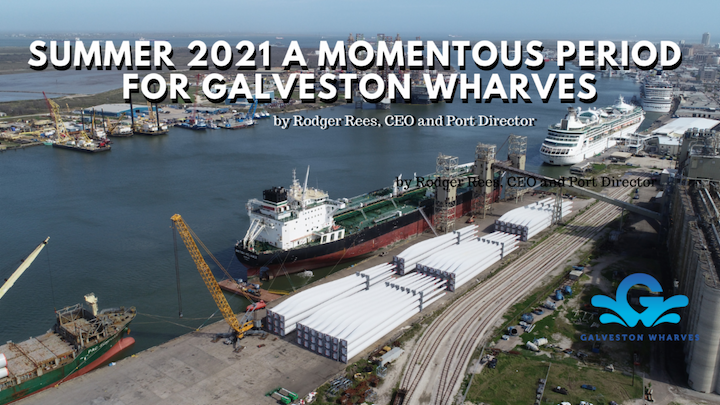Summer 2021 will go down in the Port of Galveston’s 196-year history as a momentous period of major milestones. Despite pandemic-related business disruptions and an estimated loss of more than $44 million in cruise revenues, the port moved forward with major Strategic Master Plan projects and set new business records.

Setting Sail
Restarting our cruise business is great news for the Galveston region because it accounts for about 65 percent of port revenues, 29,600 jobs statewide and $125 million in passenger and crew onshore spending annually. As a self-funding operation with no taxing authority, the port relies on its revenues, grants and partnerships to pay for much-needed improvements.
While the port’s cruise business was put on hold, the port board and staff remained focused on moving forward with Strategic Master Plan projects grouped in five main areas:
Moving Day for Ro-Ro
- Relocation of cargo operations from the east port to the west port
- Infrastructure improvements and site work to prepare Pier 10 for Royal Caribbean cruise terminal construction
- Pedestrian and vehicular traffic projects to improve safety and traffic flow
- Drainage and utility improvements
- General repairs
In June we moved a major roll-on/roll-off (ro-ro) tenant from Pier 10 to our West Port Cargo Complex. This is part of our plan to consolidate cargo operations to improve efficiencies and reduce truck traffic on Harborside Drive in the downtown area. The cargo complex provides direct access to major interstate highways and rail lines, making it an ideal location for our ro-ro, wind turbine components, grain and other cargos.
To prepare for the move, the port invested $2 million in site improvements, including paving, dock repairs, an equipment processing center, and an industrial wash pad for equipment cargo exports. The improvements accommodate large roll-on/roll-off (ro-ro) cargos such as construction and farming machinery.
New Wind Cargo Record
In May, the port set a new wind-turbine cargo record, importing more than 500 pieces, including tower sections, blades and nacelles.
We’re one of the few ports with the skilled labor, rail and roadway infrastructure to handle this huge cargo. We’ve also benefited from the addition of 17 acres of privately operated laydown area with rail service for wind components opened earlier this year.











